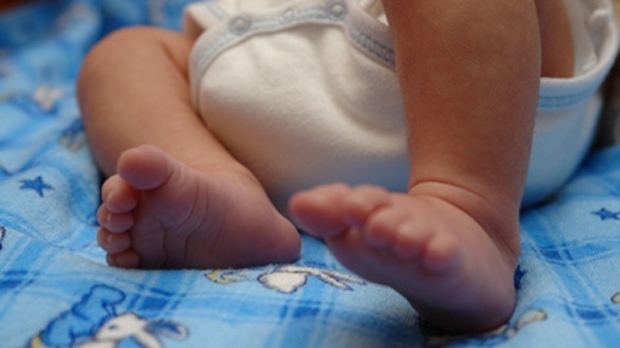About 1 in 4 times forceps are used during childbirth in Canada, a mom is injured: study
 (file photo)
(file photo)
A new study from the University of Alberta recommends limiting the use of forceps during childbirth.
U of A experts on incontinence say educating both clinicians and mothers will help to prevent lifelong injuries to women.
According to the study, Canada has an alarmingly high rate of forcep use during childbirth.
“Often women who have had this type of delivery are completely shell-shocked because they’ve got infection, they’ve got pain, they’ve got a newborn and they had no idea that this was even a possibility,” Jane Schulz, professor and chair of obstetrics and gynecology in the faculty of medicine and dentistry, explained.
“Education is needed for both patients and health providers that this is a potential complication.”
Use of forceps can lead to some immediate and long-term complications that can include infection, chronic pain, sexual dysfunction, incontinence and pelvic organ prolapse.
“These birth injuries sometimes result in conditions which are extremely troublesome in later life,” Adrian Wagg, the division director of geriatric medicine and scientific director for the AHS Seniors Health Strategic Clinical Network, added.
'WE'RE NOT DOING WELL COMPARED TO OTHER COUNTRIES'
Forceps, described as similar to “large sugar tongs,” are placed on a baby’s head to pull it out.
“The blades go around the baby’s head and can potentially tear muscles and ligaments of the pelvic floor or cause damage to the nerves that supply the pelvic floor,” Schulz said.
The study shows that researchers looked at close to two million birth records from Canada, Norway, Sweden and Austria with a focus on first-time births.
It revealed five per cent of the women had third or fourth-degree tears to their perineum. Both Canada and Sweden had the highest recorded rates of injury, whereas Austria and Norway had the lowest.
A study conducted in 2016 showed roughly 24.3 per cent of Canadian mothers with forceps deliveries were injured, in comparison to Norway where it was only 6.4 per cent.
Those injuries were associated with the use of instruments such as a vacuum or forceps during delivery, the study read.
“We’re not doing well compared to other countries that were chosen based on similar social demographics and health-care services,” Schulz said.
She added that some women are more prone to injury depending on the size of their baby or if they have a shorter perineum.
That's why both Schulz and Wagg want to improve education for clinicians to better inform new mothers of their birth options.
“I advocate for women to be fully informed about their options in childbirth and counsel women to avoid forceps if at all possible,” Wagg said. “Caesarean section is the fallback option.”
Schulz encourages patients to be assessed six weeks before childbirth to ensure they get the care they need to avoid any long-term damage.
CTVNews.ca Top Stories

Half of Canadians have negative opinion of latest Liberal budget: poll
A new poll suggests the Liberals have not won over voters with their latest budget, though there is broad support for their plan to build millions of homes.
opinion Why you should protect your investments by naming a trusted contact person
Appointing a trusted person to help with financial obligations can give you peace of mind. In his personal finance column for CTVNews.ca, Christopher Liew outlines the key benefits of naming a confidant to take over your financial responsibilities, if the need ever arises.
'One of the single most terrifying things ever': Canadian couple among tourists on sinking sailing boat tour abroad
A Toronto couple are speaking out about their “extremely dangerous” experience on board a sinking tour boat in the Dominican Republic last week.
'My stomach dropped': Winnipeg man speaks out after being criminally harassed following single online date
A Winnipeg man said a single date gone wrong led to years of criminal harassment, false arrests, stress and depression.
Ottawa injects another $36M into vaccine injury compensation fund
The federal government has added $36.4 million to a program designed to support people who have been seriously injured or killed by vaccines since the end of 2020.
Photographer alleges he was forced to watch Megan Thee Stallion have sex and was unfairly fired
A photographer who worked for Megan Thee Stallion said in a lawsuit filed Tuesday that he was forced to watch her have sex, was unfairly fired soon after and was abused as her employee.
An Ontario senior called Geek Squad for help with his printer. Instead, he got scammed out of $25,000
An Ontario senior’s attempt to get technical help online led him into a spoofing scam where he lost $25,000. Now, he’s sharing his story to warn others.
Accused of burglary at stepmother's home, U.S. senator says she wanted her father's ashes: charges
A Minnesota state senator and former broadcast meteorologist told police that she broke into her stepmother's home because her stepmother refused to give her items of sentimental value from her late father, including his ashes, according to burglary charges filed Tuesday.
Twins from Toronto were Canada's top two female finishers at this year's Boston Marathon
When identical twin sisters Kim and Michelle Krezonoski were invited to compete against some of the world’s most elite female runners at last week’s Boston Marathon, they were in disbelief.
































